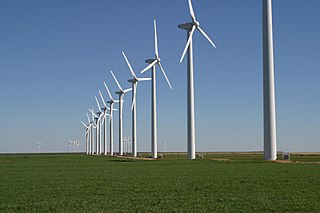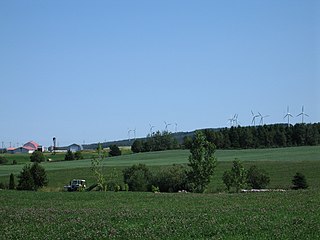
A wind farm or wind park, also called a wind power station or wind power plant, is a group of wind turbines in the same location used to produce electricity. Wind farms vary in size from a small number of turbines to several hundred wind turbines covering an extensive area. Wind farms can be either onshore or offshore.

Mercury NZ Limited is a New Zealand electricity generation and multi-product utility retailer of electricity, gas, broadband and mobile telephone services. All the company's electricity generation is renewable. Mercury has a pre-paid electricity product sub-brand GLOBUG.

Wind power is one of the main renewable energy sources in the world. In Australia, wind power contributed 10% of the total electricity supply in 2020, and 37.5% of its renewable energy supply. Wind resource testing conditions in Australia are optimal, as abundant wind resources are located close to residential areas in the southern parts of the country and on the slopes of the Great Dividing Range in the east.

Wind power is a branch of the energy industry that has expanded quickly in the United States over the last several years. From January through December 2021, 379.8 terawatt-hours were generated by wind power, or 9.23% of electricity in the United States. The average wind turbine generates enough electricity in 46 minutes to power the average American home for one month. In 2019, wind power surpassed hydroelectric power as the largest renewable energy source in the U.S.

Wind power generation capacity in India has significantly increased in recent years. As of 31 March 2023, the total installed wind power capacity was 42.633 gigawatts (GW), the fourth largest installed wind power capacity in the world. Wind power capacity is mainly spread across the southern, western, and northwestern states.

Wind power in Texas, a portion of total energy in Texas, consists of over 150 wind farms, which together have a total nameplate capacity of over 30,000 MW. If Texas were a country, it would rank fifth in the world: The installed wind capacity in Texas exceeds installed wind capacity in all countries but China, the United States, Germany and India. Texas produces the most wind power of any U.S. state. According to the Electric Reliability Council of Texas (ERCOT), wind power accounted for at least 15.7% of the electricity generated in Texas during 2017, as wind was 17.4% of electricity generated in ERCOT, which manages 90% of Texas's power. ERCOT set a new wind output record of nearly 19.7 GW at 7:19 pm Central Standard Time on Monday, January 21, 2019.

Wind power constitutes a small but growing proportion of New Zealand's electricity. As of December 2020, wind power accounts for 690 MW of installed capacity and over 5 percent of electricity generated in the country.

The Shiloh wind power plant is a wind farm located in the Montezuma Hills of Solano County, California, USA, close to Bird's Landing and Collinsville, 40 miles (64 km) northeast of San Francisco. It has a nameplate capacity of 505 megawatts (MW) of power and was built in four stages between 2005 and 2012. Several additional projects are also located in the Montezuma.
Turitea Wind Farm is a 222-megawatt wind farm near Turitea, Palmerston North, New Zealand. The farm is owned and operated by Mercury Energy.
Mill Creek Wind Farm is a wind farm in the Ohariu Valley near Wellington, New Zealand.
New York has 2,192 MW of installed wind power capacity as of 2022. Most of New York's wind power is located in upstate New York as onshore wind farms. New York has set a goal of developing 9,000 MW of offshore installed wind power capacity by 2035 that will power an estimated 6 million homes. As of October 2022, New York has five offshore wind farms in development with approximately 4,300 MW installed capacity.

Wind power in Illinois provided nearly 10% of the state's generated electrical power in 2020 powering 1,231,900 homes. At the end of 2020, Illinois had 6,300 megawatts (MW) of wind power installed, ranking fifth among states for installed wind turbine capacity. An additional 1,100 MW of wind power was under construction across the state at the end of 2020.

The Jardin d'Eole Wind Farm is a 127.5 megawatt (MW) wind farm, located in Saint-Ulric, near Matane, Quebec. It is owned and operated by Northland Power.

The US state of Colorado has vast wind energy resources and the installed electricity capacity and generation from wind power in Colorado has been growing significantly in recent years. The growth has been sustained due to a combination of falling costs, continuing federal incentives, and the state's aggressive renewable portfolio standard that requires 30% of the state's electricity to come from renewable sources by 2020.

Solar power in Florida has been increasing, as the cost of solar power systems using photovoltaics (PV) has decreased in recent years. Florida has low electricity costs compared with other states, which makes individual solar investment less attractive. Florida ranks ninth nationally in solar resource strength according to the National Renewable Energy Laboratory and tenth in solar generation by the Solar Energy Industries Association.
The Castle Hill Wind Farm is a proposed wind farm being developed by Genesis Energy. It will have up to 286 wind turbines with potential output of up to 858 MW, depending on what model(s) of wind turbines are selected. The project is estimated to cost more than $1.6 billion and will be New Zealand's largest wind farm.

Wind power in Kentucky has limited potential for development within the state since there are generally low wind speeds, though there are specific locations where it can be effective. The state has not passed renewable portfolio standard legislation and there are no commercial-scale wind turbines. Kentucky may benefit from the development of wind power in Tennessee, an adjoining state with which it is collaborating, and from efforts by the Tennessee Valley Authority to both develop and import wind-generated electricity into the region.
The Kaiwaikawe Wind Farm is a proposed wind farm to be located in the Northland Region of New Zealand. It is expected to have a maximum capacity of 73MW and use up to 19 turbines. The wind farm will be developed by Tilt Renewables.













